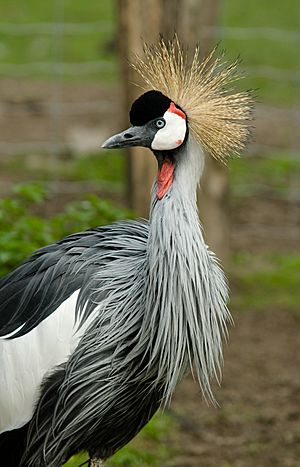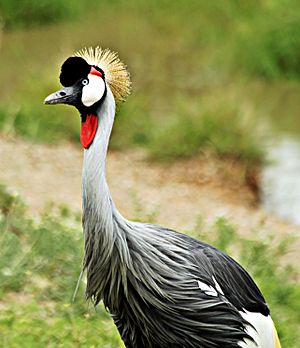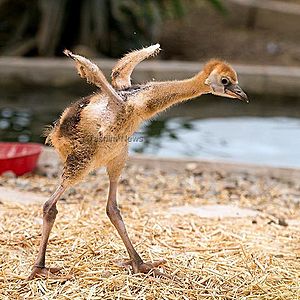Grey crowned crane facts for kids
Quick facts for kids Grey crowned crane |
|
|---|---|
 |
|
| Conservation status | |
| Scientific classification | |
| Kingdom: | |
| Class: | |
| Order: | |
| Family: | |
| Genus: |
Balearica
|
| Binomial name | |
| Balearica regulorum |
|
The grey crowned crane or East African crowned crane (Balearica regulorum) is a waterfowl species which lives in wetter areas of eastern and southern Africa. They grow up to 3.5 feet and weigh over 8 pounds. The East African crowned crane can live up to 25 years in captivity. They eat a variety of grasses, seeds, insects, and other small animals.
Contents
Description
The grey crowned crane is about 1 m (3.3 ft) tall, weighs 3.5 kg (7.7 lbs), and has a wingspan of 2 m (6.5 ft). Its body plumage is mainly grey. The wings are predominantly white, but contain feathers with a range of colours. The head has a crown of stiff golden feathers. The sides of the face are white, and there is a bright red inflatable throat pouch. The bill is relatively short and grey, and the legs are black. They have long legs for wading through the grasses. The feet are large, yet slender, adapted for balance rather than defence or grasping. The sexes are similar, although males tend to be slightly larger. Young birds are greyer than adults, with a feathered buff face.
This species and the black-crowned crane are the only cranes that can roost in trees, because of a long hind toe that can grasp branches. This trait is assumed to be an ancestral trait among the cranes, which has been lost in the other subfamily. Crowned cranes also lack a coiled trachea and have loose plumage compared to the other cranes.
Distribution and habitat

It occurs in dry savannah in Africa south of the Sahara, although it nests in somewhat wetter habitats. They can also be found in marshes, cultivated lands and grassy flatlands near rivers and lakes in Uganda and Kenya and as far south as South Africa. This animal does not have set migration patterns, and birds nearer the tropics are typically sedentary. Birds in more arid areas, particularly Namibia, make localised seasonal movements during drier periods.
Behavior
The grey crowned crane has a breeding display involving dancing, bowing, and jumping. It has a booming call which involves inflation of the red gular sac. It also makes a honking sound quite different from the trumpeting of other crane species. Both sexes dance, and immature birds join the adults. Dancing is an integral part of courtship, but also may be done at any time of the year.
Flocks of 30-150 birds are not uncommon.
Diet and feeding
These cranes are omnivores, eating plants, seeds, grain, insects, frogs, worms, snakes, small fish and the eggs of aquatic animals. Stamping their feet as they walk, they flush out insects which are quickly caught and eaten. The birds also associate with grazing herbivores, benefiting from the ability to grab prey items disturbed by antelopes and gazelles. They spend their entire day looking for food. At night, the crowned crane spends its time in the trees sleeping and resting.
Breeding
Grey crowned cranes time their breeding season around the rains, although the effect varies geographically. In East Africa the species breeds year-round, but most frequently during the drier periods, whereas in Southern Africa the breeding season is timed to coincide with the rains. During the breeding season, pairs of cranes construct a large nest; a platform of grass and other plants in tall wetland vegetation. The grey crowned crane lays a clutch of 2-5 glossy, dirty-white eggs, which are incubated by both sexes for 28–31 days. Chicks are precocial, can run as soon as they hatch, and fledge in 56–100 days.
Relationship with humans
Status and conservation
Although the grey crowned crane remains common over some of its range, it faces threats to its habitat due to drainage, overgrazing, and pesticide pollution. Their global population is estimated to be between 58,000 and 77,000 individuals. In 2012 it was uplisted from vulnerable to endangered by the IUCN.
Symbolism
The grey crowned crane is the national bird of Uganda and features in the country's flag and coat of arms.
Images for kids
See also
 In Spanish: Balearica regulorum para niños
In Spanish: Balearica regulorum para niños







